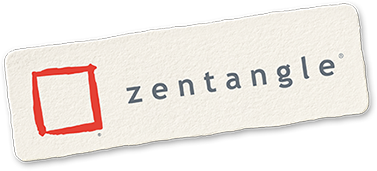Paige Scheinberg, MS, ATR-BC, CZT writes....
I remember the moment I discovered Zentangle®. I was sitting at a computer at my first art therapy internship in graduate school feeling totally overwhelmed and anxious about entering the mental health field and working with people with severe and chronic mental illness. During my short breaks between facilitating art therapy groups and seemingly endless documentation, I would often search for inspiration for new, engaging art processes that could help my clients meet their treatment goals. On this fated day, I unexpectedly discovered an image that was filled with incredible patterns that weaved in and out of each other with such beauty and intricacy. Yet, as I stayed with this image, I imagined how these patterns could be broken down into simple lines and shapes so that almost anyone could make them. After some quick research, I pleasantly discovered that this was exactly what the Zentangle Method is all about – guiding people through a simple, relaxing drawing process that also invites gratitude, acceptance, and creative fun. While beautiful art is often a product of Zentangle, it was really all about the process – just like in art therapy. I couldn’t help but think how meaningful and engaging this could be to share in art therapy sessions – and how much I would enjoy it, too!

In art therapy, we have a saying – “Don’t ask anyone to try or create anything you haven’t experienced or created yourself.” This is especially important as a mental health professional, because people can have drastically different experiences with a creative process depending on their cognitive, physical, and emotional health, past experiences with materials, and even the amount of time given to create (to name just a few considerations). Lucky for me, that has meant I’ve spent years exploring the Zentangle Method through a variety of materials and approaches to better understand what my clients’ potential sensory, cognitive, emotional, and creative experiences would be through different materials, tile designs, and projects.
And, the patterns – oh, how I love the original Zentangle patterns! From the initial process of creating patterns with clients to spending some time observing them afterwards, tangle patterns have become an abundant source of metaphor and symbolism for so many. After some initial reflection and questions, Zentangle patterns have lead my clients and me to many meaningful discussions about navigating life transitions, coping with change, cultivating strengths, savoring the good, and even understanding and influencing brain changes.

One of my first – and most memorable and affirming – experiences with tangling in an art therapy group was with a client in a forensics unit in a state hospital. After living on the unit for a number of years, this young man had experienced art therapy with many art therapists and explained, “I’ve done it all. I’m not really interested anymore.” He occasionally attended groups briefly, but often complained of headaches (likely a part of his auditory hallucinations) and preferred to be alone and walk around the unit for most of the day. While I still felt new to the Zentangle Method, I figured I’d give it a try – what did we have to lose? I told our group I was still learning how to tangle and that we’d discover this process together. That day, this restless young man not only came to the session, but stayed and created the entire group. As we continued to tangle in the weeks to come, his engagement continued, however, his headaches and anxiety seemed to disappear during our groups. He even took on a leadership role in the group for a few sessions, picking out a pattern, practicing it, and then guiding our group through the creative process.
After one of these groups with him, I found myself at my computer again searching for Zentangle, but this time, I emailed Rick and Maria. I told them about my work as a new art therapist and how empowering, relaxing, and effective I was finding the Zentangle Method – and asked what I could do to get more involved. As fate would have it, a spot unexpectedly opened in the CZT training a few months later – and I’ve been finding ways to incorporate my love and enthusiasm for Zentangle into my work as a mental health professional ever since.
From schools and hospitals to museums and people’s homes, I’ve found the Zentangle Method to help people reduce anxiety and stress, increase focus and motivation, improve self-concept, mood, and motor skills, feel a sense of pride, accomplishment, and peace, and build connections with others and their creative selves. It brings me such joy to know that all of this is accessible to so many at almost anytime. All you really need is a square piece of paper, a pen, and a focus on the process – and, of course, our breath, gratitude, and an invitation to our other dear Bijousims.

These days, you can most often find me offering Zentangle at an adult outpatient cancer center as part of an array of services that I offer through our Integrative Oncology Division. By integrating the Zentangle Method into art therapy and mindfulness sessions, I have been able to help cancer survivors and caregivers relax during infusion treatments, stay grounded during life transitions, explore creativity and problem-solving, and even feel joy and peace while healing from treatment, in the hospital, or processing the unexpected. As a mental health professional, I have also found the Zentangle Method to be invaluable for my own creativity and well-being. It’s not uncommon for me to grab a piece of paper and a pen for some tangling between sessions to feel the benefits of my own creative, compassionate moments of breath, appreciation, ease, and enjoyment.
IG / FB @shineonwithpaige
SHINEONconsulting.com
--- + ---
Thank you to all who shared your thoughts on our last blog, Tangling Your Own Conclusions. We have randomly selected Eileen Larsen to receive a new Zentangle MantraBand! Please send your snail mail address to julie@zentangle.com.



Meg Steele on
The bonus of science to back up the dynamics of this fusion at once is what draws me to Zentangle. Thank you for helping so many with mental challenges and the desire to be sane for even a moment.
Ann Hatcher on
Ginny Stiles on
That is a wonderful testimony to the power of Zentangling. So many people find it the creative outlet they’ve been looking for all their lives.
Ann Baum on
Diane Harpster on
This is a beautiful story. Thank you for sharing it.
Kitty Canupp on
This is a beautiful story. Thank you for sharing it.
Kitty Canupp on